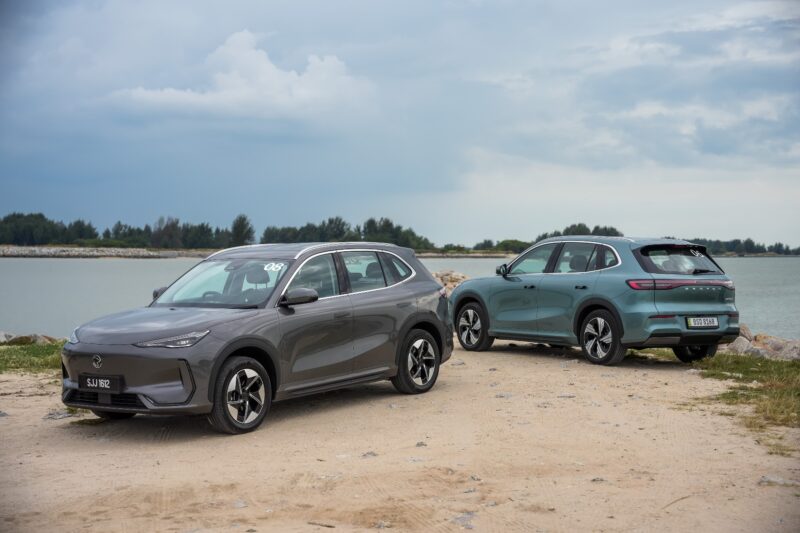In September last year, I had the opportunity to drive the twin model of the Proton eMAS 7, the Geely Galaxy E5.
Rather than putting the Galaxy E5 through its paces at the Proton Centre of Excellence (COE) test track, we hit the roads around Puncak Alam for a more authentic experience.
As I observed, the suspension system of the Galaxy E5 is not particularly suited to the road conditions we face here. It is a tad too soft and tends to bounce and sway on undulating surfaces.
While this kind of setup may cater to customers in China, Proton needs to draw upon its expertise to ensure that the eMAS 7 is equipped to handle the more challenging roads of Malaysia.
Which is why I was quite excited when invited to test drive the eMAS 7 from Shah Alam to Melaka. I was eager not only to experience Proton’s magic firsthand but also because this was my first time getting up close with the nation’s very first EV.
Exterior Design
Many are already aware that the exterior appearance of the eMAS 7 does not differ significantly from that of the Galaxy E5. Both models feature the same headlight and taillight designs, L-shaped daytime running lights (DRLs), and identical bumpers.
Of course, the front bumper of the Proton showcases the Proton eMAS logo, which is slightly different from the traditional Proton logo. Meanwhile, the ‘PROTON’ lettering beneath the rear lights and the ‘eMAS 7’ badge on the tailgate solidify the identity of this EV at the back.
I have no complaints about this, as the eMAS 7 certainly looks sharp and robust in the metal. Its sleek headlights and wide taillights give it an air of sophistication that belies its price.
Interior Space
It comes as no surprise that the interior layout of the eMAS 7 closely resembles that of the Galaxy E5. However, Proton has opted for a darker colour scheme in the eMAS 7 instead of the lighter white found in its twin.
While light colours can create a sense of spaciousness, the darker tones lend the eMAS 7 a more sophisticated feel. This choice is also more popular among Malaysian buyers simply because it is easier to maintain.
In terms of material quality, there are no substantial differences. The leather upholstery that covers much of the dashboard, seats, and steering wheel is delightfully soft to the touch.
However, I was somewhat disappointed to find that the footrest for the front passenger seat has been omitted, likely for cost-saving reasons.
Features
Despite this, the eMAS 7 boasts all the features offered in the Galaxy E5. This includes a 15.4-inch touchscreen, a 10.2-inch driver’s instrument panel, and a Wanos audio system with 16 speakers from Flyme Sound.
These include those integrated into the driver’s headrest, which serves to channel navigation instructions directly to the driver’s ears.
Unfortunately, the systems for Apple CarPlay and Android Auto are still not available, though an update is expected this year via an over-the-air (OTA) release.
This is not too much of a concern, as the built-in navigation system of the eMAS 7 is user-friendly, despite the map’s appearance being in need of some refinement.
What I find most interesting about this system is its ability to locate nearby charging stations.
According to Proton, the system can identify over 1,700 charging points nationwide, thanks to partnerships with various charging point operators such as Gentari, JomCharge, chargEV, DC Handal, Carput Zap, and ChargeSini.
The system provides detailed information about the selected charging stations, including the operator, type, number, capacity and availability of chargers, rates, and much more.
Performance
Both the Prime and Premium variants of the eMAS 7 feature a single electric motor on the front axle, generating 218 PS (160 kW) and 320 Nm of torque.
The key difference between these variants lies in battery capacity: 49.52 kWh for the Prime and 60.22 kWh for the Premium. The Prime offers a WLTP driving range of 375 km, while the Premium extends this by an additional 65 km.
Driving from Shah Alam to Melaka, I had no worries about the vehicle’s range, as the distance is about 160 km, which is less than half the capacity offered by the Premium variant.
To assess the efficiency of this ‘12-in-1’ powertrain, I drove leisurely at speeds of around 90 to 100 km/h. Upon arriving at my destination, the energy consumption indicated a figure of around 10 to 11 kWh per 100 km, meaning I had used less than 30% of the battery’s energy for this journey.
Handling
Proton’s engagement in the eMAS 7/Galaxy E5 project is evident in the real-world performance of the eMAS 7’s suspension system.
The differences between the two models are notably pronounced, with the eMAS 7 demonstrating superior ride quality and handling characteristics.
The retuned dampers provide greater stability and tranquility at high speeds, while still managing to maintain comfort at lower speeds.
The steering feel is commendable for an EV, and the NVH (noise, vibration, and harshness) levels are impressive, with exterior noise being effectively muted. Road noise is minimal, even though this variant is fitted with 19-inch rims.
Conclusion
Personally, I find the eMAS 7 quite intriguing. Priced between RM109,800 and RM129,800, it offers excellent value for those keen to explore the world of EVs.
While the relatively short driving range may be a concern for frequent long-distance travellers, for those who do not regularly embark on such journeys, the eMAS 7 is definitely worth considering.
Specifications for the Proton eMAS 7 Premium
Price: RM129,800
Power: 218 PS (160 kW)
Torque: 320 Nm
Battery: 60.22 kWh
Driving Range: 410 km (WLTP)
